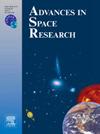Star angle modified with relativistic effects/StarNAV integrated navigation method for Mars exploration
IF 2.8
3区 地球科学
Q2 ASTRONOMY & ASTROPHYSICS
引用次数: 0
Abstract
The celestial navigation system based on star angle (SA) is a classical autonomous navigation method for the spacecraft, which directly provides the position information of the spacecraft relative to the near celestial body. But due to the relativistic effects, the star direction observed by spacecraft is inconsistent with that acquired from star ephemeris, which reduces navigation accuracy of SA. In addition, SA cannot directly provide the velocity information of the spacecraft. StarNAV is a novel celestial navigation method that utilizes the relativistic effects, which mostly provides the velocity information of the spacecraft. In this paper, the star angle modified with relativistic effects (SAMRE)/StarNAV integrated navigation method is proposed. The measurement model of SAMRE is established by considering relativistic effects in the measurement model of SA. Simulation results indicate that during the Mars approach phase, SAMRE has better navigation accuracy compared with SA, and the navigation accuracy of the SAMRE/StarNAV integrated navigation method is higher than that of SAMRE, StarNAV and SA/StarNAV, respectively. Furthermore, the paper analyses the impact of measurement errors on the navigation accuracy of SAMRE/StarNAV.
利用相对论效应修正星角/StarNAV 集成导航方法用于火星探测
基于星角(SA)的天体导航系统是一种经典的航天器自主导航方法,它直接提供航天器相对于近天体的位置信息。但由于相对论效应,航天器观测到的星体方向与星历表获得的星体方向不一致,从而降低了 SA 的导航精度。此外,SA 无法直接提供航天器的速度信息。StarNAV 是一种利用相对论效应的新型天体导航方法,主要提供航天器的速度信息。本文提出了利用相对论效应修正星角(SAMRE)/StarNAV 集成导航方法。通过在 SA 测量模型中考虑相对论效应,建立了 SAMRE 的测量模型。仿真结果表明,在火星接近阶段,SAMRE 与 SA 相比具有更好的导航精度,SAMRE/StarNAV 集成导航方法的导航精度分别高于 SAMRE、StarNAV 和 SA/StarNAV。此外,本文还分析了测量误差对 SAMRE/StarNAV 导航精度的影响。
本文章由计算机程序翻译,如有差异,请以英文原文为准。
求助全文
约1分钟内获得全文
求助全文
来源期刊

Advances in Space Research
地学天文-地球科学综合
CiteScore
5.20
自引率
11.50%
发文量
800
审稿时长
5.8 months
期刊介绍:
The COSPAR publication Advances in Space Research (ASR) is an open journal covering all areas of space research including: space studies of the Earth''s surface, meteorology, climate, the Earth-Moon system, planets and small bodies of the solar system, upper atmospheres, ionospheres and magnetospheres of the Earth and planets including reference atmospheres, space plasmas in the solar system, astrophysics from space, materials sciences in space, fundamental physics in space, space debris, space weather, Earth observations of space phenomena, etc.
NB: Please note that manuscripts related to life sciences as related to space are no more accepted for submission to Advances in Space Research. Such manuscripts should now be submitted to the new COSPAR Journal Life Sciences in Space Research (LSSR).
All submissions are reviewed by two scientists in the field. COSPAR is an interdisciplinary scientific organization concerned with the progress of space research on an international scale. Operating under the rules of ICSU, COSPAR ignores political considerations and considers all questions solely from the scientific viewpoint.
 求助内容:
求助内容: 应助结果提醒方式:
应助结果提醒方式:


